After wrapping up our visit to
John Ignacio's Austin garden we—that's John,
Pam and I—then took a short jaunt to see a neighbor's garden that John helped to build during COVID lockdown. It just so happened that Pam and I had passed this garden on our way to John's place, we were pretty happy to be getting a closer look. This sort of oblong, street-side, island planting was the reason for our visit.
If I've got my story straight, John and the garden's owner, Coleson, had originally bonded over their unusual homes (don't worry, we'll see Coleson's home later in this post) and then, as it happens, they got to talking about plants. This island bed was in need of a make-over and the time was right, they got to work...
Cylindropuntia leptocaulis, I wonder if this plant came as a cutting from John's plant?
The main feature of this planting is the limestone crevice garden, as such it faces the house and driveway.
While my eye was immediately drawn to the barrel cactus at the top—and the similarly golden spikes just below the barrel—there are a lot of other interesting plants tucked in those crevices.
A moment to appreciate the barrel...
…and then a look at some of the smaller plants.
Spiky planting pockets.
Of course, there are agaves...oh and palms too!
I have no idea what they are, other than fabulous.
Done admiring the island, our gaze shifted to the far corner of the property and what Pam and I had first spotted as we drove by, those tall metal planters and their spiky contents: dasylirion on the street-side.
Opuntia on the next row in...
...and an interesting collection in the shorter planters even further in...
Looking out, beyond, I couldn't help but admire the toasted skeleton of an opuntia that must have been grand, once upon a time. I assume this was a causality of the February '21 Freeze that Austinites and their plants endured. If you look close there is some green...
There were a few agaves over here as well, fighting off the encroaching foliage of Caesalpinia pulcherrima (I think ?).
I love this combo, soft and spiky. We know who will when this battle...
Now, we finally turn to look towards the house and it's unusual holey-rock (limestone) wall.
I first saw skulls. Hundreds of skulls. Kinda creepy, right? But thankfully not.
Opposite the oblong island is this row of potted citrus that Coleson adopted from John.
Moving towards the front walkway... Yucca rostrata!
Pretty fabulous, am I right? Those slightly curved trunks are just a touch more exotic than my boring old straight trunked Y. rostrata.
An then there's this, another crevice garden—this one in the bend between the home and the garage.
Another combined effort of John and Coleson, John however was quick to point out the labor of actually setting the stones was all Coleson...
From front door, looking out across the plantings...
...and a couple of close-ups...
After this front garden tour, Coleson generously took us into his home to share the views out into the the garden, pointing out how the Yucca rostrata placement was carefully considered for how it blocked the windows (privacy) as well as provided an indoor view. We continued through the house—there were a few WOW moments—onto the back patio, and around the side of the house. I didn't take any photos inside, or on the back deck, because it seemed like a very personal space and I wanted to respect that.
On the far side of the house though I was taken with these square cement planters.
An idea I might steal as a short retaining wall next to our driveway.
Finally, while editing photos for this post, I became curious about what that island planting looked like before John and Coleson worked their magic on it. Thanks to Google maps I went back in time and have six iterations to share with you. This fist version, tiny agaves and opuntia adrift in a sea of shimmering rock, dates to May of 2009. Note the tightly clipped hedge and sea of lawn...
It's April 2011 now and changes are happening. The fabulous offset rectangular entry steps are being poured and either a large agave from the previous planting was allowed to stay, or a new one was being moved in, hard to tell.
More agaves! Always a good choice. The uni-brow hedge is gone now and replaced by individual plants, October 2013.
January 2015 and things look either drought-stressed or dormant. Are you curious about that black blob on the front porch? I was. Page up and you can see it was a large potted Strelitzia reginae, the orange blooming bird of paradise, presumably wrapped against winter cold.
May of 2016. The strelitzia on the porch lives on, and one of the agaves sends up its bloom stalk.
The last photo I have to share is from July of 2019. There's still a lot of lawn, and it looks like the island is mostly Caesalpinia pulcherrima (I think). Solar panels have moved in on the roof though, a smart move in a sunny place like Austin, as is removing all that lawn—and of course the addition of fabulous plants and the crevice garden(s).
Thanks again to Coleson for his incredible hospitality, and John for paving the way into this amazing property. Over the weekend I listened to Jennifer Jewel's November interview of
Christopher Woodward, Director of London's Garden Museum, and he repeated a phrase I've said many times, something along the lines of "gardeners are just good people". Yes they are, very generous and kind people.
— — —
All material © 2009-2021 by Loree Bohl for
danger garden. Unauthorized reproduction prohibited and just plain rude.









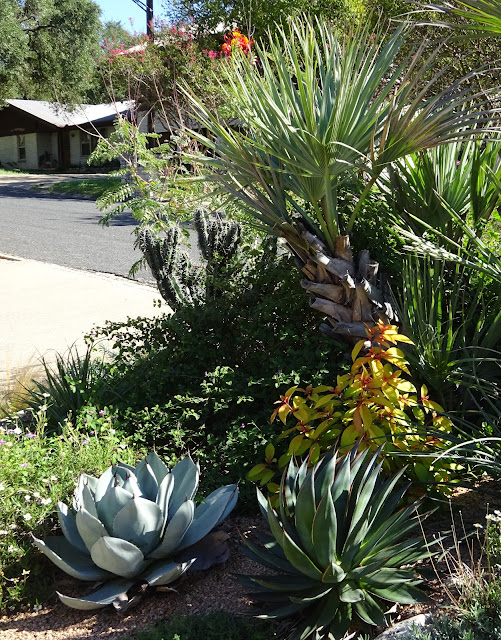



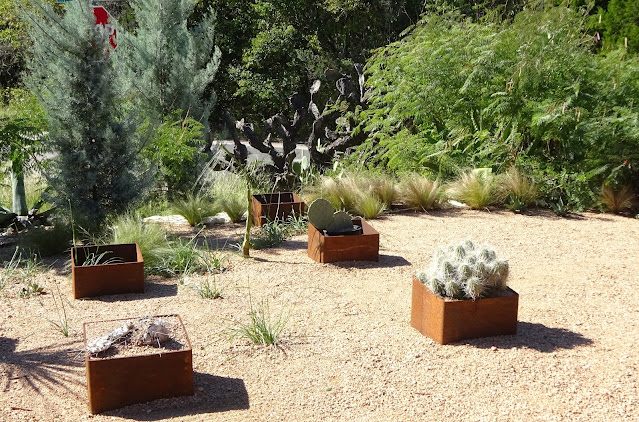
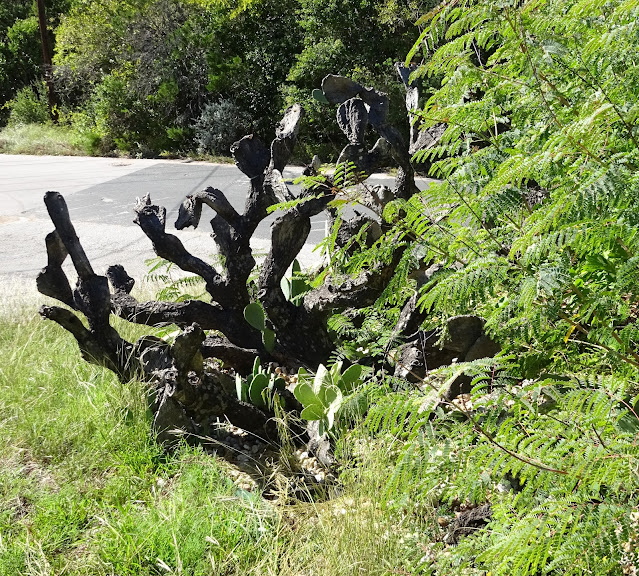





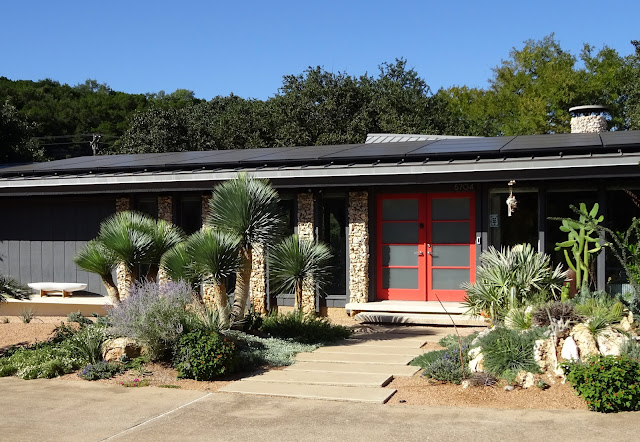
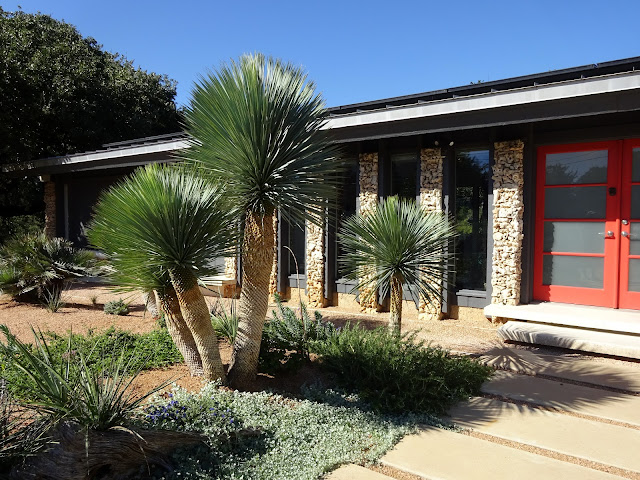





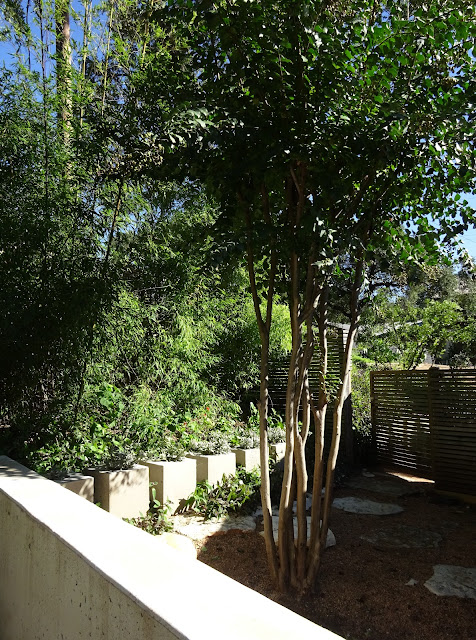
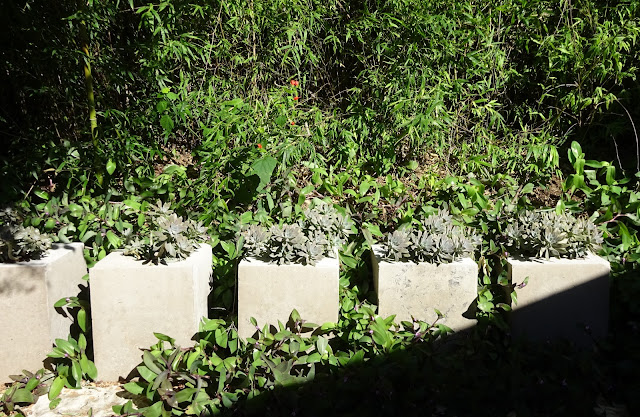
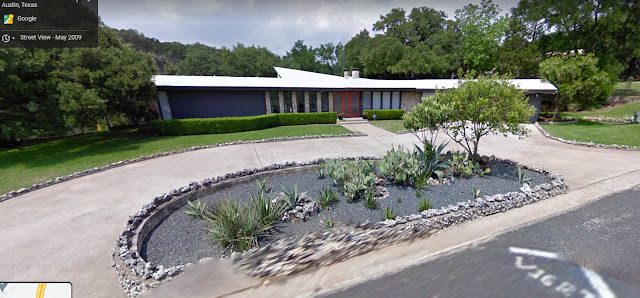



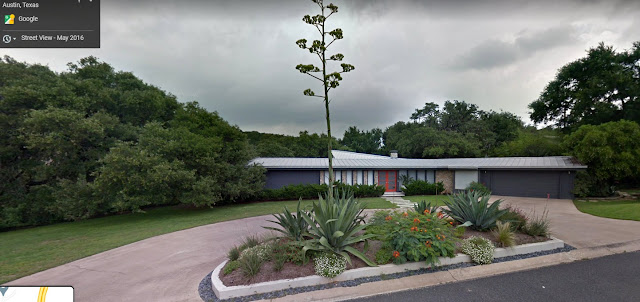
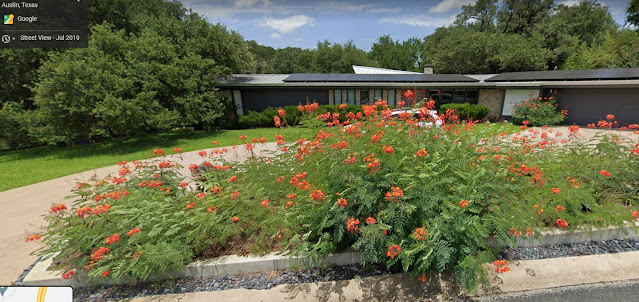
Those have to be the best crevice gardens I've ever seen. Love the old photos to get a sense of how big the changes have been. From blah to breathtaking.
ReplyDelete"From blah to breathtaking"... yes! I wonder what the neighbor's have had to say? I should have asked.
DeleteO.M.G. The plants are awesome, but the real star is that limestone! What I wouldn't give for a load of that. This is the kind of succulent-heavy crevice garden I've been wanting to create for years now. It looks so good! Heck, everything looks fantastic here. I'm so happy you got to visit.
ReplyDeleteAs for the leaning Y. rostrata trunks, our largest rostrata, maybe 7 ft. tall, leans quite a bit. Maybe I should stop worrying about it??
Stop worrying! And yes, the limestone certainly amps things up doesn't it? Using a local stone, one with so much character, certainly grounded the project in it's place.
DeleteIndeed - Limestone is pretty much everywhere in Austin, as you can see in the cliffs across the road. Initially Coleson wanted to use tall limestone pillars with a bore cut through them in lieu of those tall steel planters. We had found one long piece at the stone yard and were asking if they had more. When they didn't, as we had already purchased the pieces there, we had them saw them into short equal segments which are now that row of planters with graptoverias in them in the back. Yes, that's a kind of grey limestone known locally as leuder stone, not concrete. So that retaining wall, like so many of the other elements of the garden was one of those "Now what are we going to do with these to look good." outcomes. Colesons choice of the matching color succulent for those provides a great contrast for that wall of bamboo behind them.
DeleteThose rostrata's were the first placement in the garden bought from a local field grower who has a whole couple acres of them in east Austin. There's a whole story just about trying to get them in the ground and hitting CLINK an old uncollapsed septic tank. It's ultimate demise provided the deep, well drained soil under them that ultimately led to them growing 18" in their first year. Coleson's worry now is they'll lose that well planned street blockage before too long. Another of the joys of gardening, contending with the growth and evolution of living art.
John Ignacio
Limestone not concrete, I never would have guessed!
DeleteA lot to learn from this garden. The crevice sections were beautifully done. Working with rock that large is something I can only imagine. The use of identical containers is very effective, creating a modern vibe. However, my favorite thing may be that Opuntia carcass with life springing forth within its skeleton. I'll also admit that I loved that mass of colorful Caesalpinia in the 2019 garden as well ;)
ReplyDeleteThat opuntia "carcass" as you call it was so statuesque. I hope that it stands for a long time.
DeleteGreat garden, stunn9ng house
ReplyDeleteYes!
DeleteThis garden was fabulous, and it was fun to hear John and Coleson talking about their collaboration on it. And you KNOW I was crazy for that house too, inside and out. BTW, the January picture is just winter dormancy. That's how our winters look here in Austin.
ReplyDeleteI think by the time we were in this garden my mind was starting to prepare for the evening's activities (my talk) and I wasn't entirely in the present. I regret that and look forward to your post to help round out the garden for me.
DeleteI agree with Gerhard, that Texas limestone is such a scene-stealer. And the ingenuity that results, in the right hands and flexible cast of mind, from not shying away but exploring the rigors of this climate always astonishes me. Gardens like Coleson's make it look easy, yet we know what they're up against in creating them.
ReplyDeleteYour comment sums it all up so well Denise, thank you.
DeleteVery cool to see the progression series of photos. I like the final one with all the flowers but the current design is far more interesting. I got a laugh from your first impression of the stone wall as that was my first thought too. An Indiana Jones type moment.
ReplyDeleteGlad I wasn't alone. Being a PNW girl you just don't see stone like that!
DeleteWonderful textures and plant combinations... beautiful work!
ReplyDeleteYes indeed.
DeleteI've have seen some of your other photos on the limestone and I have always wondered whether the gardener places the stones on their sides to create the crevices?
ReplyDeleteI'm not sure I understand your question Nancy, but yes... crevice gardens are usually built with stone (or sometimes "urbanite"—recycled concrete) placed on it's side.
DeleteTo create the crevices stones have to be placed on their sides vs stacked. Allows the roots to go down deep.
DeleteBonding over home and garden... sounds perfect.
ReplyDeleteA lot of changes still took place between the 2019 google photo and the current garden, most noticeably the added crevice garden. The stone is beautiful and so different than the crevice gardens I saw from the Denver fling.
Leaning Yucca rostrata or straight, the front entry to this house is gorgeous; the floating steps really push the design up a notch.
Agreed, that entry is stunning and the steps are perfect!
DeleteI also agree with Linda that this is one of the finest crevice gardens. I'd put it in top ten earth-wide. Maybe even top five. And there's a lot of them now. Exemplary. Bravo, Coleson. Bravo.
ReplyDeleteThe style is really in keeping with the nature of limestone; exciting to see such a quality example in Texas, where it will be seminal- CGs are not so common there as yet.
Also- the time-travel with google streetside is brilliant!
I'm glad you saw this post Kenton, and that you give the gardens such high marks. I'm sure Coleson and John will be happy to hear the U.S. crevice garden master thinks so highly of their work!
DeleteGreat garden and so much more evocative of its location than a green lawn and unibrow hedge. The TX limestone is fabulous mixed in with xeric plants--wish we could get it here. The house/garden work so well together.
ReplyDeleteThink "popcorn", not "skulls"?
Some of the palms might be Chaemerops? One of the most cold hardy. K has that Caesalpinia--puts on such a glorious show every summer.
Thanks for showing us this beauty.
John (below) confirms, there are two Chamaerops. Thanks for the popcorn suggestion. Had I not seen skulls to start with I might have been able to go with popcorn but no, skulls it will always be.
DeleteThere are two Chamaerops cerifera, though not so visible in most of the photos. The far left end of the island crevice garden is Mazari palm (Nannorrhops ritchiana) from Afghanistan that we fortunate to score from a local palm importer/wholesaler. At the far right end of the island crevice, and across the drive from it, are Sonoran palms (Sabal uresana). Close to the house in the crevice garden across from the Yucca rostrata is a large blue form of Serenoa repens, and nearby to it is a Sabal minor.
ReplyDeleteJohn I.
I really need to work on my palm ID skills. Thanks for the names John.
DeleteI've come back to share my post about Coleson's garden, in case anyone wants to see more. It sure was fun seeing what he and John have made! https://www.penick.net/digging/?p=79152
ReplyDeleteThank you, Pam and Loree, for all the encouragement! Really honored to share it!
Delete